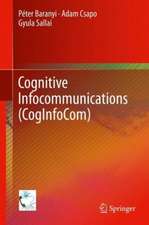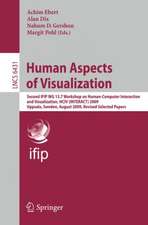Minimalism: Designing Simplicity: Human–Computer Interaction Series
Autor Hartmut Obendorfen Limba Engleză Paperback – 30 noi 2011
Possible uses of the notion of minimalism in the field of human–computer interaction design are examined both from a theoretical and empirical viewpoint, giving a range of results. Minimalism defines a radical and potentially useful perspective for design analysis. The empirical examples show that it has also proven to be a useful tool for generating and modifying concrete design techniques.
Divided into four parts this book traces the development of minimalism, defines the four types of minimalism in interaction design, looks at how to apply it and finishes with some conclusions.
| Toate formatele și edițiile | Preț | Express |
|---|---|---|
| Paperback (1) | 990.12 lei 6-8 săpt. | |
| SPRINGER LONDON – 30 noi 2011 | 990.12 lei 6-8 săpt. | |
| Hardback (1) | 996.56 lei 6-8 săpt. | |
| SPRINGER LONDON – 3 iul 2009 | 996.56 lei 6-8 săpt. |
Din seria Human–Computer Interaction Series
- 20%
 Preț: 655.85 lei
Preț: 655.85 lei - 20%
 Preț: 309.25 lei
Preț: 309.25 lei - 20%
 Preț: 375.54 lei
Preț: 375.54 lei - 20%
 Preț: 644.48 lei
Preț: 644.48 lei - 20%
 Preț: 667.75 lei
Preț: 667.75 lei - 20%
 Preț: 664.44 lei
Preț: 664.44 lei - 20%
 Preț: 1164.84 lei
Preț: 1164.84 lei - 20%
 Preț: 817.55 lei
Preț: 817.55 lei - 20%
 Preț: 657.16 lei
Preț: 657.16 lei - 20%
 Preț: 645.31 lei
Preț: 645.31 lei - 20%
 Preț: 938.66 lei
Preț: 938.66 lei - 15%
 Preț: 658.05 lei
Preț: 658.05 lei - 20%
 Preț: 822.51 lei
Preț: 822.51 lei - 20%
 Preț: 654.21 lei
Preț: 654.21 lei - 20%
 Preț: 994.26 lei
Preț: 994.26 lei - 20%
 Preț: 1621.89 lei
Preț: 1621.89 lei - 20%
 Preț: 991.60 lei
Preț: 991.60 lei - 20%
 Preț: 783.45 lei
Preț: 783.45 lei - 20%
 Preț: 1175.42 lei
Preț: 1175.42 lei - 20%
 Preț: 659.97 lei
Preț: 659.97 lei - 20%
 Preț: 219.15 lei
Preț: 219.15 lei - 20%
 Preț: 334.86 lei
Preț: 334.86 lei - 20%
 Preț: 969.84 lei
Preț: 969.84 lei - 20%
 Preț: 642.19 lei
Preț: 642.19 lei - 20%
 Preț: 314.39 lei
Preț: 314.39 lei - 20%
 Preț: 661.14 lei
Preț: 661.14 lei - 20%
 Preț: 995.89 lei
Preț: 995.89 lei - 20%
 Preț: 752.58 lei
Preț: 752.58 lei - 20%
 Preț: 990.30 lei
Preț: 990.30 lei - 20%
 Preț: 336.21 lei
Preț: 336.21 lei - 20%
 Preț: 334.71 lei
Preț: 334.71 lei - 20%
 Preț: 312.62 lei
Preț: 312.62 lei - 20%
 Preț: 994.92 lei
Preț: 994.92 lei - 20%
 Preț: 331.74 lei
Preț: 331.74 lei - 20%
 Preț: 646.80 lei
Preț: 646.80 lei - 20%
 Preț: 334.86 lei
Preț: 334.86 lei - 20%
 Preț: 994.40 lei
Preț: 994.40 lei - 20%
 Preț: 329.76 lei
Preț: 329.76 lei - 20%
 Preț: 332.24 lei
Preț: 332.24 lei - 20%
 Preț: 992.11 lei
Preț: 992.11 lei - 20%
 Preț: 650.40 lei
Preț: 650.40 lei - 20%
 Preț: 337.00 lei
Preț: 337.00 lei - 20%
 Preț: 332.39 lei
Preț: 332.39 lei - 20%
 Preț: 1279.86 lei
Preț: 1279.86 lei - 15%
 Preț: 636.12 lei
Preț: 636.12 lei - 20%
 Preț: 336.67 lei
Preț: 336.67 lei - 20%
 Preț: 1000.70 lei
Preț: 1000.70 lei - 20%
 Preț: 645.14 lei
Preț: 645.14 lei
Preț: 990.12 lei
Preț vechi: 1237.65 lei
-20% Nou
Puncte Express: 1485
Preț estimativ în valută:
189.45€ • 198.34$ • 156.76£
189.45€ • 198.34$ • 156.76£
Carte tipărită la comandă
Livrare economică 05-19 aprilie
Preluare comenzi: 021 569.72.76
Specificații
ISBN-13: 9781447122845
ISBN-10: 1447122844
Pagini: 360
Ilustrații: XX, 340 p. 99 illus.
Dimensiuni: 155 x 235 x 19 mm
Greutate: 0.5 kg
Ediția:2009
Editura: SPRINGER LONDON
Colecția Springer
Seria Human–Computer Interaction Series
Locul publicării:London, United Kingdom
ISBN-10: 1447122844
Pagini: 360
Ilustrații: XX, 340 p. 99 illus.
Dimensiuni: 155 x 235 x 19 mm
Greutate: 0.5 kg
Ediția:2009
Editura: SPRINGER LONDON
Colecția Springer
Seria Human–Computer Interaction Series
Locul publicării:London, United Kingdom
Public țintă
ResearchCuprins
Designing for an Age of Complexity.- Minimalism: Introduction and Synopsis.- Defining Minimalism.- In Search of “Minimalism”— Roving in Art, Music and Elsewhere.- Minimalism for Interaction Design: a Proposal.- Rethinking Minimalism.- Minimalism, Industrial Design and HCI.- Minimalism, Simplicity and Rules of Design.- Applying Minimalism.- Detecting the Minimal.- Designing the Minimal.- Reflections on Minimalism.- Minimalism Revisited.- Minimal Aesthetics.- Unconnected Ends.- Conclusion.
Recenzii
From the reviews:
"This book discusses human-computer interaction (HCI) through four well-defined notions of minimalism: functional minimalism, structural minimalism, architectural minimalism, and compositional minimalism. … This book will interest product development teams and project leaders, as well as people who work in marketing and people who are involved in the political process. HCI students and designers shouldn’t bypass this book." (Constantin S. Chassapis, ACM Computing Reviews, November, 2009)
"This book discusses human-computer interaction (HCI) through four well-defined notions of minimalism: functional minimalism, structural minimalism, architectural minimalism, and compositional minimalism. … This book will interest product development teams and project leaders, as well as people who work in marketing and people who are involved in the political process. HCI students and designers shouldn’t bypass this book." (Constantin S. Chassapis, ACM Computing Reviews, November, 2009)
Textul de pe ultima copertă
In this age of complexity, simple, powerful systems are an ideal of interaction design. This book introduces minimalism and helps to make sense of reduction, and in doing so unravels some of the mysteries of simplicity. Minimalism becomes an essential tool to help visualise the simple, and to unveil and instantiate patterns for designing simplicity.
Divided into five parts, the first delivers an introduction to the concept of minimalism and overviews the main themes covered in the book; Part two retraces the history of minimalism in art and music illustrating the breadth of concepts underlying works characterized as minimal, and showing the recurrence of these attributes in different disciplines. Four kinds of minimalism for interaction design are defined. The third part connects the concepts developed in the book to current thinking in HCI, examining norms, rules and guidelines. In part four, the simplicity of real designs is examined from a minimal perspective, and tools for different forms of reduction in design are discussed. The final section returns to more theoretical discussions of the notions of minimalism, re-evaluating the product and process threads for the changes brought about for the understanding of minimalism and the relation of aesthetics and minimalism in design. The book concludes with a look at issues and limitations that lie unanswered, and some of their possible resolutions.
Divided into five parts, the first delivers an introduction to the concept of minimalism and overviews the main themes covered in the book; Part two retraces the history of minimalism in art and music illustrating the breadth of concepts underlying works characterized as minimal, and showing the recurrence of these attributes in different disciplines. Four kinds of minimalism for interaction design are defined. The third part connects the concepts developed in the book to current thinking in HCI, examining norms, rules and guidelines. In part four, the simplicity of real designs is examined from a minimal perspective, and tools for different forms of reduction in design are discussed. The final section returns to more theoretical discussions of the notions of minimalism, re-evaluating the product and process threads for the changes brought about for the understanding of minimalism and the relation of aesthetics and minimalism in design. The book concludes with a look at issues and limitations that lie unanswered, and some of their possible resolutions.
Caracteristici
Features a constructive theoretical framework: Simplicity - an often-cited design value is analysed using the notion of minimalism Transdisciplinary approach to design of interactive systems Includes supplementary material: sn.pub/extras






















